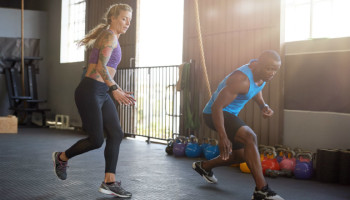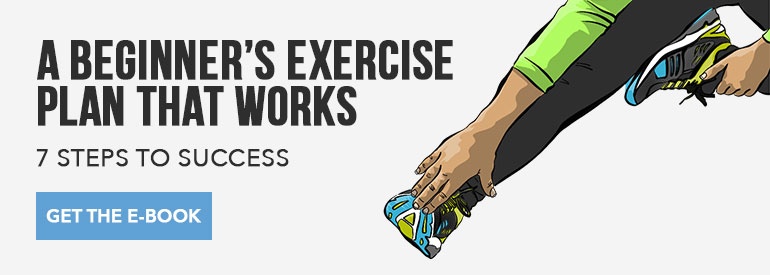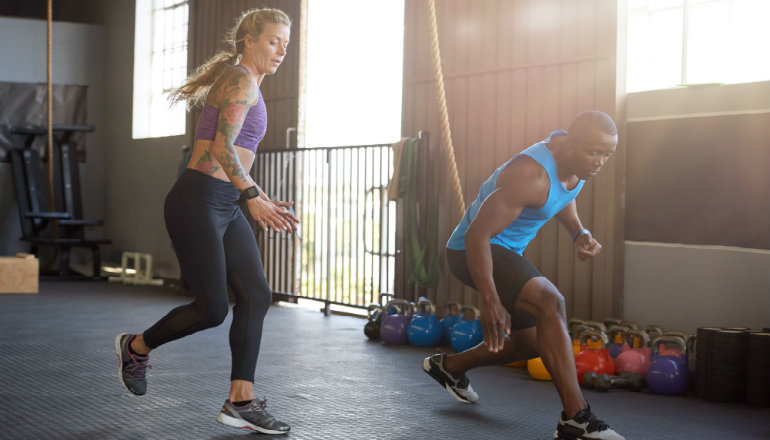 Reading Time: 6 minutes
Reading Time: 6 minutesHigh intensity interval training (HIIT) is a hot fitness trend, but while many people have jumped on this mode of exercise, many also don’t really understand how HIIT works, the science behind it, or what a HIIT program actually consists of.
This HIIT technique involves giving an all-out effort of intense exercise for a short time, followed by a brief rest period. With HIIT training, you’re able to perform at an intensity you can’t sustain for long, and then recover so you’re able to do it again, and again, and again. In doing so, HIIT combines two of the best fat-burning methods — maximum oxygen use and maximum effort.
This approach to training gets you out of your comfort zone and offers many health and weight-loss benefits. But is HIIT training more effective than low- to moderate-intensity cardio, and if so, what’s the science behind it?
The Science Behind HIIT Training
Most people who want to burn fat and improve aerobic capacity turn to long, moderate-intensity cardio workouts. However, studies show that HIIT training offers a more effective way to reach those same goals.
When you work out at an intensity you’re unable to sustain for a long time, a couple things start to happen. First, you’ll feel burning in your muscles. Second, you’ll feel out of breath. When you exert yourself, your muscles build up lactic acid, which causes that burning feeling, and your body’s stores of oxygen become depleted. High intensity training forces your body to work even harder to build the stores of oxygen back up, and research shows that your body continues working to build oxygen stores for sixteen to 24 hours after you cease exercise.
Multiple studies show that HIIT workouts burn more calories both during and after exercise, boosting weight-loss results. In addition, the Journal of Applied Physiology published a study showing that HIIT training increases the capacity for fat oxidation in women.
And because of the intensity of HIIT workouts, there’s a significant increase of catecholamines within your body, hormones that are activated when the body is stressed. These hormones help mobilize the body’s fat stores so they can be used as fuel.
HIIT workouts also help improve your VO2 max, which refers to the body’s ability to use oxygen as energy. This results in improved endurance, allowing you to sustain intense workouts for longer and increasing your overall energy levels. Both aerobic and anaerobic endurance are improved with HIIT training as well, while moderate cardio workouts only improve aerobic endurance.
Benefits of HIIT Training
The science behind HIIT training is pretty impressive, but if you’re not convinced that HIIT is worth giving a shot, look at some of the benefits this type of training has to offer.
- You’ll no longer have an excuse to skip your workout because HITT workouts are convenient and fast. Whether you have ten, twenty, or thirty minutes to devote to exercise, you can do a workout in that time. One study published in the Journal of Physiology found that men who did sprint interval training for just twelve minutes three times per week saw the same results as men who were doing forty to sixty minutes of cycling five times weekly.
- Most people find HIIT more enjoyable than low-intensity forms of exercise. In fact, studies have shown that people report getting greater enjoyment out of a HIIT workout than they do with moderate workouts. And if you love it, you’re more likely to stick with it.
- HIIT workouts help you build a stronger, better heart. Research done by Liverpool John Moores University found that HIIT training reduces the stiffness of the aorta and blood vessels. This increased elasticity of arteries and blood vessels allows for easier flow of oxygen and blood through the body. This reduces your risk of stroke and heart attack.
- According to the AARP, HIIT workouts can lower your risk of diabetes. Studies on individuals with existing metabolic syndrome found that engaging in HIIT training eliminated their problems with metabolic syndrome, while other studies have found that HIIT improved insulin sensitivity, therefore reducing the risk of type 2 diabetes.
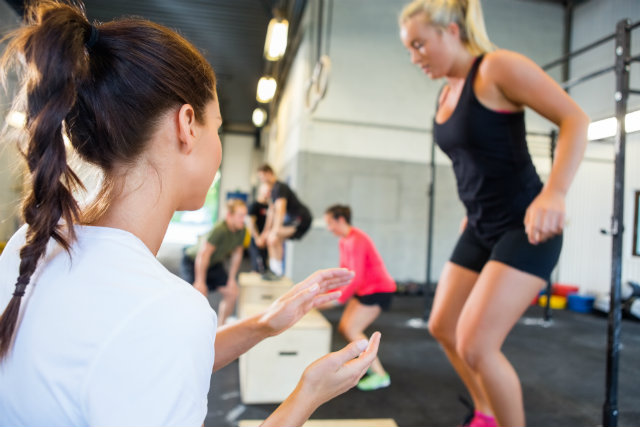
How to Do HIIT Workouts
HIIT workouts sound great, but they can be strenuous for beginners or anyone who has not been exercising regularly. The key is to start off easy and progressively add difficulty to your workouts according to your fitness level. Pushing your body is key to success, but you need to know the difference between challenging yourself and pushing your body beyond its limits.
A great format to start with is to do high-intensity movements for 30-60 seconds, then rest for 30-60 seconds. The high-intensity moves could be bodyweight exercises, sprints on a bike, or sprints on a treadmill. If you’re doing bodyweight exercises, try to choose moves that work multiple muscles at the same time, like squats, burpees, or other compound movements.
Remember, HIIT is all about intensity, so focus on maintaining your intensity, even if that means doing fewer sets at first. You can keep adding more sets as you build up your body.
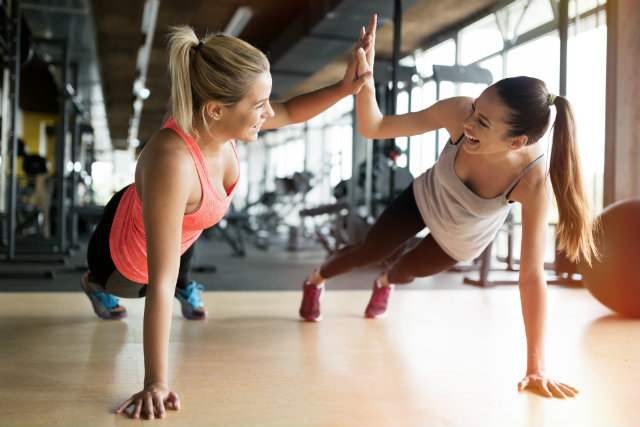
2 HIIT Workouts You Can Do Today
Whether you have ten minutes or thirty minutes to spare, here are a couple HIIT workouts you can try yourself today.
10-Minute Beginner HIIT Routine
You don’t need any equipment to get started with this beginner’s HIIT routine. Do each exercise for 20 seconds and then rest for 10 seconds. Cycle through the exercises as numbered until you’ve completed 10 minutes total of exercise (including the rest periods).
- Left-Right Punching Combo – Stand with your left foot forward, hips angled slightly to your right side. Place your arms up in a boxing position. Throw a straight punch with your left hand, then follow it up by throwing a punch with your right arm, rotating your right hip forward as you do so. Reset yours arms and hips back to the original position. Repeat.
- Right-Left Punching Combo – Do the same sequence as above, but stand with your right foot forward and start with the right side. Note: either exercise one or exercise two is likely to feel awkward for you, but don’t fuss about that, just keep moving.
- Sumo Squats – Place feet a bit further than hip-width apart with toes pointing out. Keep back straight, chest upright, and weight on the heels. Lower down until thighs are parallel to the ground. Engage the quads and glutes, push back up.
- Jumping Jacks – Do jumping jacks as quickly as possible. If they’re too difficult or uncomfortable for you, try stepping from side to side while you raise your arms up to the ceiling.
30-Minute Advanced HIIT Routine
This workout will challenge your upper body and core, and really get your cardiovascular system going. Do each of the following exercises for as many reps as you can during the 45-second work interval. Do three rounds, resting for a minute between each full round.
3 rounds, cycling through each exercise for 45-seconds work followed by 15-seconds rest:
- Push-ups
- Side lunges
- Sit-ups
- Jumping jacks
- Squats
- Triceps dips
- Butt-kickers
- 1-minute rest
Have Fun with HIIT Workouts
As you engage in HIIT workouts, remember that your body is going to take a bit longer to recover from these high-intensity workouts than more moderate workouts. So, as a beginner, you shouldn’t engage in HIIT workouts daily.
Between workout days, engage in stretching, light cardio, yoga, and other exercises that increase blood flow to aid in your recovery. Remember, proper recovery is important to getting stronger and reaping all the benefits of your exercise routine.
Most of all, stay safe, listen to your body, and have fun getting healthier!
